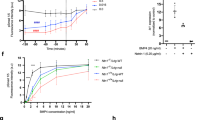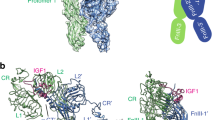Abstract
Nerve growth factor (NGF) is involved in the development and maintenance of the nervous system. NGF binds with high affinity to the extracellular region of the tyrosine kinase receptor TrkA. This domain comprises leucine and cysteine rich motifs, followed by two immunoglobulin like (Ig-like) domains. We describe the expression and purification of recombinant Ig-like domains. Fluorescence and circular dichroism spec-troscopy show that the protein is folded into a compact globular structure and contains mainly β-sheet secondary structure. Recombinant protein binds to NGF and can inhibit NGF bioactivity both in vitro and in vivo.
This is a preview of subscription content, access via your institution
Access options
Subscribe to this journal
Receive 12 print issues and online access
$209.00 per year
only $17.42 per issue
Buy this article
- Purchase on Springer Link
- Instant access to full article PDF
Prices may be subject to local taxes which are calculated during checkout
Similar content being viewed by others
References
Hatanaka, H., Tsuku, H., and Nihonmatsu, I. 1988. Developmental change in the nerve growth factor action from induction of choline acetyltransferase to promotion of cell survival in cultured basal forebrain cholinergic neurons from postnatal rats. Dev. Brain Res. 39: 85–95.
Thoenen, H., Bandtlow, H. and Heumann, R. 1987.The physiological function of nerve growth factor in the central nervous system: comparison with the periphery.Rev. Physiol. Biochem. Pharmacol. 109: 145–178.
Olsen, L., Nordburg, A., von Hoist, H., Backman, I., Ebendal, T., Alafuzoff, I., et al. 1992 Nerve growth factor affects 11 C-nicotine binding, blood flow, EEG and verbal episodic memory in an Alzheimer patient (case report). Neural Transm. Park. Dis. Dement. Sect. 4: 79–95.
Rodriguez-Tebar, A., Dechant, G., Gotz, R., and Barde, Y.A. 1992 Binding of neurotrophin-3 to its neuronal receptors and interactions with nerve growth-factor and brain-derived neurotrophic factor. EMBO J. 11: 917–922.
. Martin-Zanca, D., Oskam, R., Mitra, G., Copeland, T., and Barbacid, M. 1989. Molecular and biochemical-characterization of the human trk proto-oncogene. Mol. Cell Biol. 9: 24–33.
Ip, N.Y., Stitt, T.N., Tapley, P., Klein, R., Glass, D.J., Fandl, J., et al. 1993 Similarities and differences in the way neurotrophins interact with the trk receptors in neuronal and nonneuronal cells. Neuron 10: 137–149.
Klein, P.,, Lamballe, F., Bryant, S., and Barbacid, M. 1982. The trkB tyrosine protein-kinase is a receptor for neurotrophin-4. Neuron 8: 947–956.
Lamballe, F., Klein, R., and Barbacid, M., 1991. TrkC, a new member of the trk family of tyrosine protein-kinases, is a receptor for neurotrophin-3. Cell 66: 967–979.
Urfer, R., Tsoulfas, P., Soppet, D., Escandon, E., Parada, L.F., and Presta, L.G. 1994. The binding epitopes of neurotrophin-3 to its receptors trkC and gp75 and the design of a multifunctional human neurotrophin. EMBOJ. 13: 5896–5909.
Schneider, R., and Schweiger, M. 1991. A novel modular mosaic of cell adhesion motifs in the extracellular domains of the neurogenic trk and trkB tyrosine kinase receptors. Oncogene 6: 1807–1811.
Williams, A.F., and Barclay, A.N. 1988. The immunoglobulin superfamily-domains for cell-surface recognition. Ann. Rev. Immunol. 6: 381–405.
McDonald, N.Q., and Chao, M.V. 1995. Structural determinants of neurotrophin action. J. Blol. Chem. 270: 19669–19672.
Perez, P., Coll, P.M. Hempstead, B.L., Martin-Zanca, D. and Chao, M.V. 1995. NGF binding to the trk tyrosine kinase receptor requires the extracellular immunoglobulin-like domains. Mol. Cell. Neurosci. 6: 97–105.
Urfer, R., Tsoulfas, P., Oconnell, L., Shelton, D.L., Parada, L.F., and Presta, L.G. 1995. An immunoglobulin-like domain determines the specificity of neurotrophin receptors.EMBOJ. 14: 2795–2805.
Windisch, J.M., Marksteiner, R., and Schneider, R. 1995. Nerve growth-factor binding-site on trkA mapped to a single 24-amino acid leucine-rich motif. J. Biol. Chem. 270: 28133–28138.
Clary, D.O., and Reichardt, L.F. 1994. An alternatively spliced form of the nerve growth-factor receptor trka confers an enhanced response to neurotrophin-3. Proc. Natl. Acad. Sci. USA 91: 11133–11137.
Alien, S.J., Dawbarn, D., Eckford, S.D., Wilcock, G.K., Ashcroft, M., Colebrook, S.M., et al. 1994. Cloning of a noncatalytic form of human trkb and distribution of messenger-RNA for trkb in human brain. Neuroscience 60: 825–834.
Yang, J.T., Wu, C.S.C., and Martinez, H.M. 1986. Calculation of protein conformation from circular-dichroism. Methods Enzymol. 130: 208–269.
Ikeda, K., Hamaguchi, K., and Migita, S. 1968 Circular dichroism of Bence-Jones proteins and immunoglobulins. J. Biochem. 63: 654–660.
Vale, R.D., and Shooter, E.M. 1985. Assaying binding of nerve growth-factor to cell-surface receptors. Methods Enzymol. 109: 21–39.
Loeb, D.M., Maragos, J., Martinzanca, D., Chao, M.V., Parada, L.F., and Green, L.A. 1991. The trk protooncogene rescues NGF responsiveness in mutant NGF-nonresponsive PC12 cell-lines. Cell 66: 961–966.
Kaplan, D.R., Hempstead, B.L., Martinzanca, D., Chao, M.V., and Parada, L.F. 1991. The trk protooncogene product?a signal transducing receptor for nerve growth-factor. Science 252: 554–558.
Fujimori, K., and Fukuzono, S. 1992 Overproduction of biologically-active human nerve growth factor in Escherichia coli. Biosci. Biotech. Biochem. 56: 1985–1990.
Otten, U., Baumann, J.B., and Girard, J. 1984. Nerve growth-factor induces plasma extravasation in rat skin. Eur. J. Pharmacol 106: 199–201.
Bennett, G.S., and Brain, S.D., 1996 Nerve growth-factor induces an immediate and also a late-phase of edema formation in rat skin. Br. J. Pharmacol. 119: P55.
de Vos, A.M., Ultsch, M., Kossiakoff, A.A. 1992. Human growth-hormone and extracellular domain of its receptor-crystal-structure of the complex. Science 255: 306–312.
Yayon, A., Zimmer, Y. Shen, G.H., Avivi, A., Yarden, Y., and Givol, D. 1992. A confined variable region confers ligand specificity on fibroblast growth-factor receptors-implications for the origin of the immunoglobulin fold. EMBO J. 11: 1885–1890.
Ze, W., Myles, G.M., Brandt, C.S., Lioubin, M.N., and Rohrschneider, L. 1993. Identification of the ligand-binding regions in the macrophage-colony-stimulating factor-receptor extracellular domain. Mol. Cell Biol. 13: 5348–5359.
Diamond, M.S., Staunton, D.E., Marlin, S.D., and Springer, T.A. 1991 Binding of the integrin Mac-1 (CD11b/CD18) to the 3rd immunoglobulin-like domain of ICAM-1 (CD54) and its regulation by glycosylation. Cell 65: 961–971.
Heidaran, M.A., Mahadevan, D., and Larochelle, W.J. 1995 Beta-PDGFr-igG chimera demonstrates that human beta-PDGFR ig-like domain-1 to domain-3 are sufficient for high-affinity PDGF-BB binding. FASEB J. 9: 140–145.
Windisch, J.M., Marksteiner, R., Lang, M.E., Auer, B. and Schneider, R. 1995. Brain derived neurotrophic factor, neurotrophin-3, and neurotrophin-4 bind to a single leucine-rich motif of TrkB. Biochemistry 34: 11256–11263.
MacDonald, J.I.S., and Meakin, S.O. 1996. Deletions in the extracellular domain of Rat TrkA lead to an altered differentiate phenotype in neurotrophin responsive cells. Mol. Cell. Neurosci. 7: 371–390.
Lewin, G.R. 1995. Neurotrophic factors and pain. Semin. Neurosci. 119: P55.
Rost, B., and Sander, C. 1993. Prediction of protein secondary structure at better than 70-percent accuracy. J. Mol. Biol. 232: 584–599.
Sambrook, J., Fritsch, E.R., and Maniatis, T. 1989. Molecular cloning: a laboratory manual. Cold Spring Harbour Laboratory Press, Cold Spring Harbour, NY.
Treanor, J.J.S., Dawbarn, D., Alien, S.J., Macgowan, S.H., and Wilcock, G.K. 1991. Low affinity nerve growth-factor receptor-binding in normal and Alzheimer's-disease basal forebrain. Neuroscience Letters. 121: 73–76.
Brain, S.D., and Williams, T.J. 1985 Inflammatory edema induced by synergism between calcitonin gene-related peptide (CGRP) and mediators of increased vascular-permeability. Br. J. Pharmacol. 86: 855–860.
Author information
Authors and Affiliations
Rights and permissions
About this article
Cite this article
Holden, P., Asopa, V., Robertson, A. et al. Immunoglobulin-like domains define the nerve growth factor binding site of the TrkA receptor. Nat Biotechnol 15, 668–672 (1997). https://doi.org/10.1038/nbt0797-668
Received:
Accepted:
Issue Date:
DOI: https://doi.org/10.1038/nbt0797-668
This article is cited by
-
Exploring Missense Mutations in Tyrosine Kinases Implicated with Neurodegeneration
Molecular Neurobiology (2017)
-
A novel mutation within the extracellular domain of TrkA causes constitutive receptor activation
Oncogene (2001)
-
Entering the domain of neurotrophin binding
Nature Biotechnology (1997)



